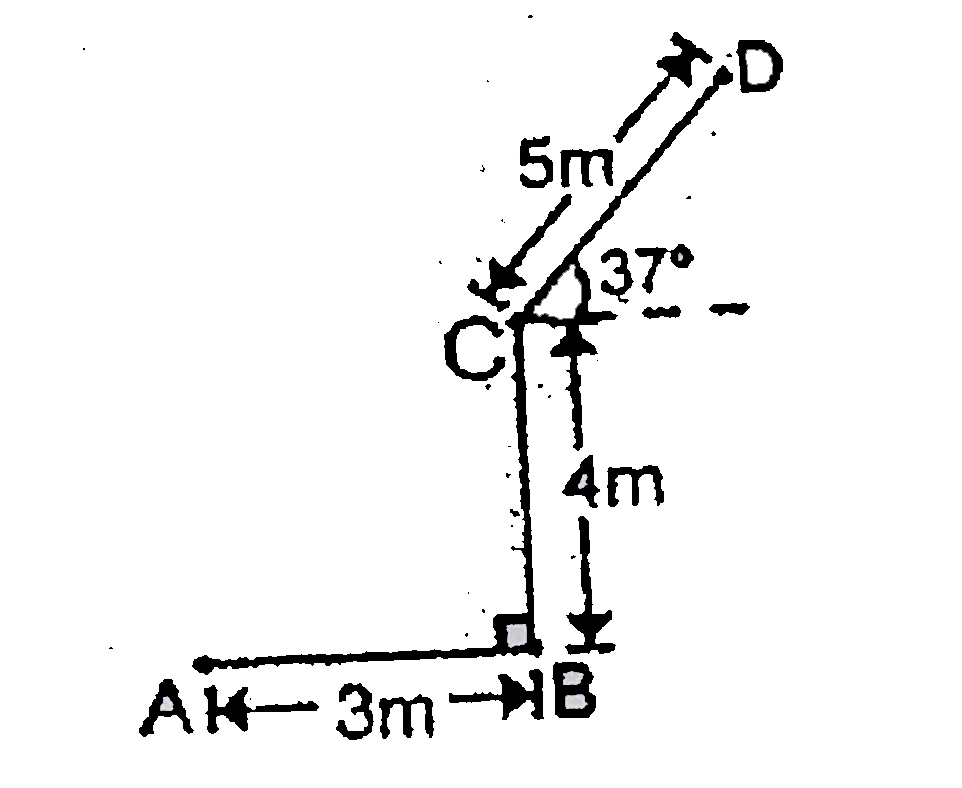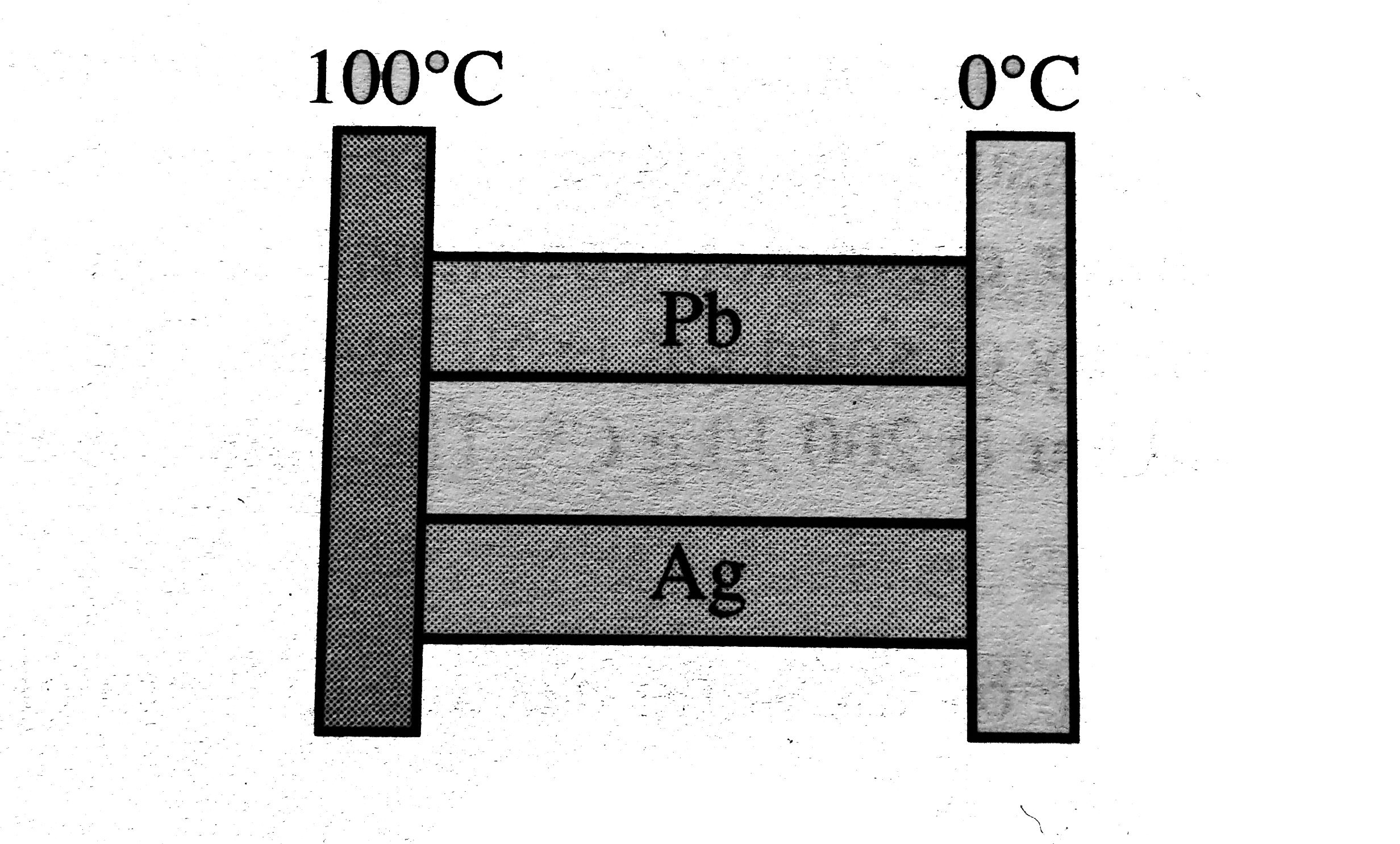Figure shows in cross section a wall consisting of four layers with thermal conductivities K1=0.06W/mK,K3=0.04W/mKandK4=0.10W/mK. The layer thickness are L1=1.5cm,L3=2.8cmandL4=3.5cm. The temperature of interfaces is as shown in figure. energy transfer through the wall is in steady state. the temperature of the interface between layer 3and4 is:

−1∘C
−3∘C
2∘C
0∘C
The correct Answer is:B
In steady state ΔQΔT∣∣∣layer1=ΔQΔt∣∣∣layer4
⇒0.06×A×(30−25)1.5×10−2=0.10×A×ΔT3.5×10−2
⇒ΔT=7∘C
T3=(−10+7)∘C=−3∘C
Topper's Solved these Questions
- HEAT TRANSFERBOOK - RESONANCE ENGLISHCHAPTER - HEAT TRANSFEREXERCISE - Exercise-2
1 Videos
- HEAT TRANSFERBOOK - RESONANCE ENGLISHCHAPTER - HEAT TRANSFEREXERCISE - Exercise-3
1 Videos
- HEAT TRANSFERBOOK - RESONANCE ENGLISHCHAPTER - HEAT TRANSFEREXERCISE - Exercise-1
1 Videos
- GRAVITATIONBOOK - RESONANCE ENGLISHCHAPTER - GRAVITATIONEXERCISE - Exercise
21 Videos
- KINEMATICSBOOK - RESONANCE ENGLISHCHAPTER - KINEMATICSEXERCISE - Exercise
65 Videos
Similar Questions
Two identical square rods of metal are welded end to end as shown in figure (a). Assume that 10 cal of heat flows through thr rod in 2min. Now the rods are welded as shown in figure (b). The time it would take for 10 cal to flow through the rods now, is

View SolutionVariation of radiant energy Eλ emitted by sun, filament of tungsten lamp and welding arc as a function of its wavelength as shown in the figure. Which of the following option is the correct match ?

View SolutionA uniform slab of dimension 10cm×10cm×1cm is kept between two heat reservoir at temperatures 10∘C and 90∘C. The larger surface areas touch the reservoirs. The thermal conductivity of the material is 0.80Wm−1C−1 . Find the amount of heat flowing through the slab per minute.
View SolutionA point mass m is placed inside a spherical shell of radius R and mass M at a distance R2 form the centre of the shell. The gravitational force exerted by the shell on the point mass is
View SolutionA particle moves along a path ABCD as shown in the figure. Then the magnitude of net displacement of the particle from position A to D is:

View Solution
Two insulated metal bars each of length 5 cm and rectangular cross section with sides 2 cm and 3 cm are wedged between two walls, one held at 100∘C and the other at 0∘C. The bars are made of lead and silver. Kpb=350W/mK,KAg=425W/mK.
Total thermal current through the two bar system is
View Solution
Two insulated metal bars each of length 5 cm and rectangular cross section with sides 2 cm and 3 cm are wedged between two walls, one held at 100∘C and the other at 0∘C. The bars are made of lead and silver. Kpb=350W/mK,KAg=425W/mK.
Equevalent thermal resistence of the two bar system is
View SolutionFigure shows in cross section a wall consisting of four layers with thermal conductivities K_(1) = 0.06 W // mK, K_(3) = 0.04 W// mK and K_(4) = 0.10 W// mK . The layer thickness are L_(1) = 1.5 cm, L_(3) = 2.8 cm and L_(4) = 3.5 cm . The temperature of interfaces is as shown in figure. energy transfer through the wall is in steady state. the temperature of the interface between layer 3 and 4 is:
View SolutionIf layer thickness L2 is 1.4cm, then its thermal conductivity K2 will have value (in W/mK)
View SolutionFigure shows in cros section a wall consisting of four layers with thermal conductivities K_(1)=0.06W//mK K_(3)=0.04W//mK and K_(4)=0.10W//mK . The layer thicknesses are L_(1)=1.5cm,L_(3)=2.8 cm and L_(4)=3.5cm the temperature of interfaces is as shown in figure. energy transfer through the wall is in steady state. Q. The temperature of the inteface between layers 2 and 3 is
View SolutionTemperature shows in cross section a wall consisting of four layers with thermal conductivities K_(1)=0.06W//mK,K_(3)=0.04W//mK and K_(4)=0.10W//mK the layer thickness are L_(1)=1.5cm,L_(3)=2.8cm and L_(4)=3.5 cm. The temperature of interfaces is as shown in figure energy transfer through the wall is in steady state. Q. Electric power of heater is:
View SolutionTemperature shows in cross section a wall consisting of four layers with thermal conductivities K_(1)=0.06W//mK,K_(3)=0.04W//mK and K_(4)=0.10W//mK the layer thickness are L_(1)=1.5cm,L_(3)=2.8cm and L_(4)=3.5 cm. The temperature of interfaces is as shown in figure energy transfer through the wall is in steady state. Q. Temperature of outer surface of sphere is
View SolutionTemperature shows in cross section a wall consisting of four layers with thermal conductivities K_(1)=0.06W//mK,K_(3)=0.04W//mK and K_(4)=0.10W//mK the layer thickness are L_(1)=1.5cm,L_(3)=2.8cm and L_(4)=3.5 cm. The temperature of interfaces is as shown in figure energy transfer through the wall is in steady state. Q. Thickness of hollow sphere is
View SolutionTwo walls of thicknes l1 and l2 and ther-mal condctivities K1 and K2 are in contact In the steady state, if the temperature at the outer faces are T1 and T2 find the temperature at the common wall .
View SolutionTwo plates each of area A thickness L1 and L2 thermal conductivities K1 and K2 respectively are joined to from a single plate of thickness (L1+L2) If the temperatures of the free surfaces are θ1 and θ2 Calculate
(a) Rate of flow of heat
(b) Temperature of interface
 .
.
View SolutionThe figure shows the cross-section of the outer wall of a house buit in a hill-resort to keep the house insulated from the freezing temperature of outside. The wall consists of teak wood of thickness L1 and brick of thickness (L2=5L1), sandwitching two layers of an unknown material with identical thermal conductivites and thickness. The thermal conductivity of teak wood is K1 and that of brick is (K2=5K). Heat conducion through the wall has reached a steady state with the temperature of three surfaces being known. (T1=25∘C,T2=20∘C and T5=−20∘C). Find the interface temperature T4 and T3.

View Solution
